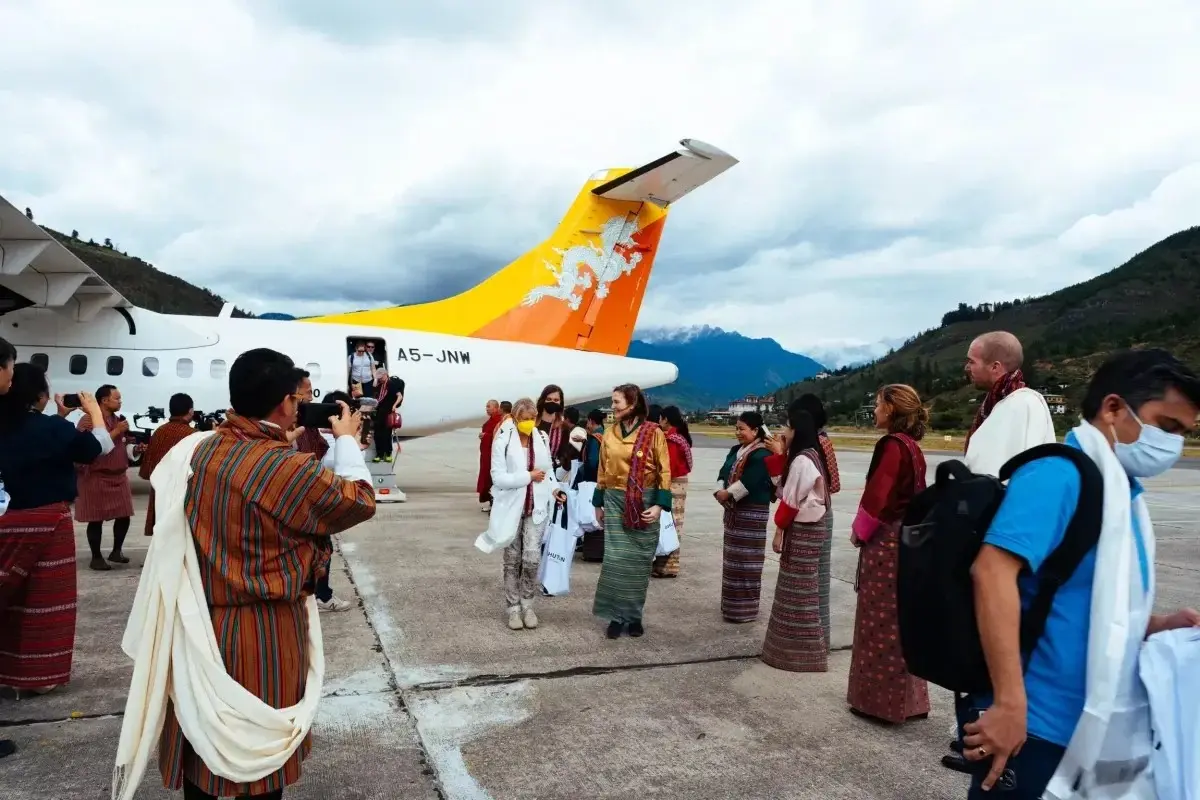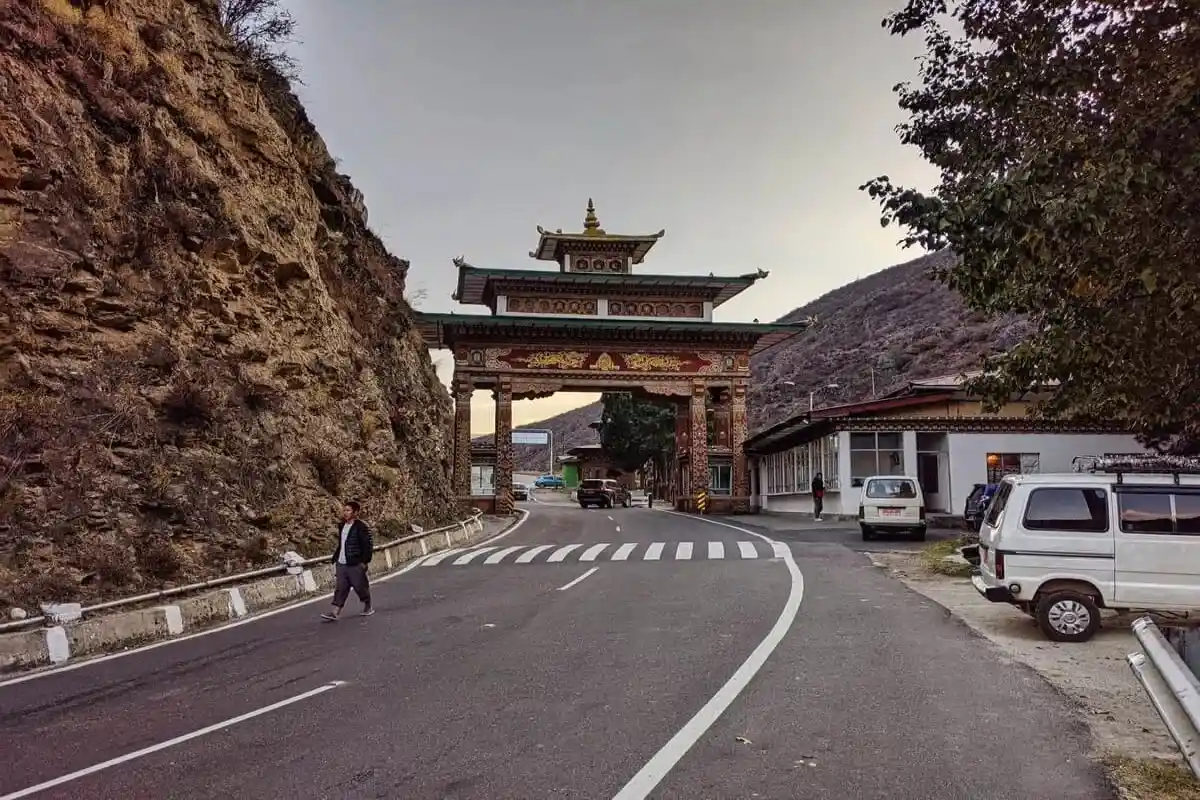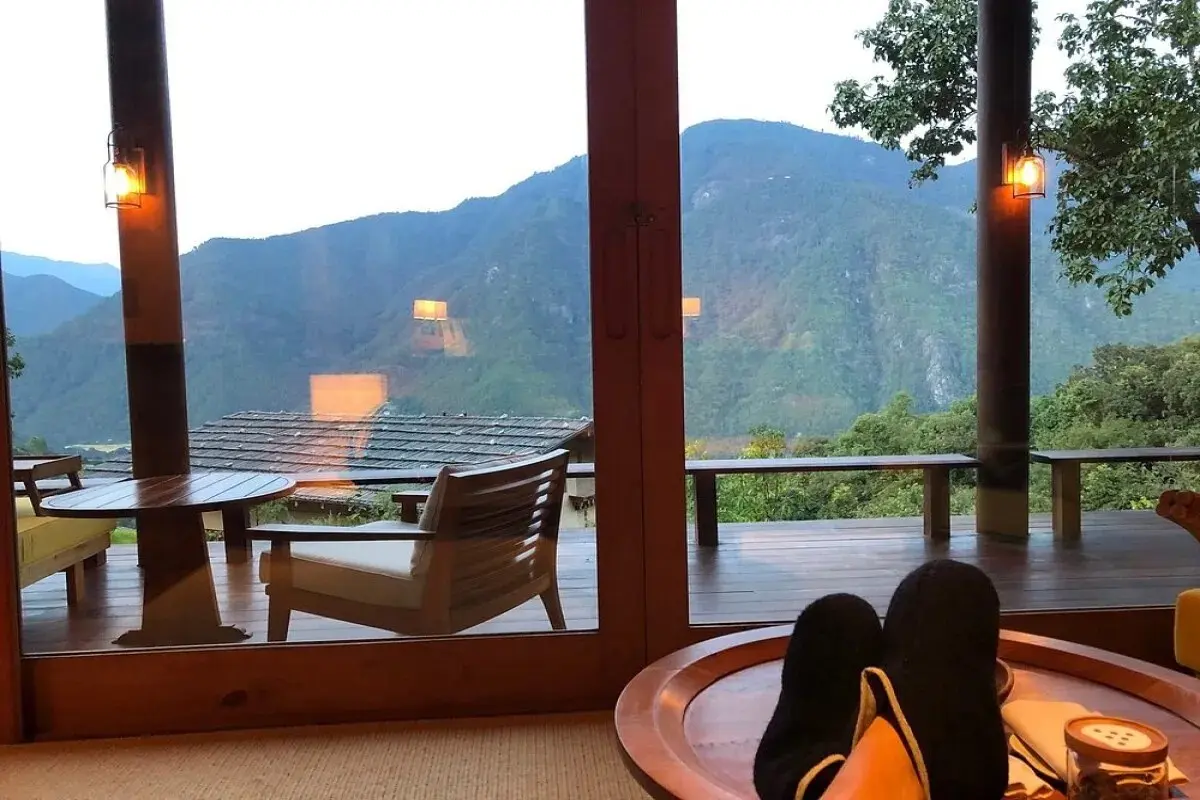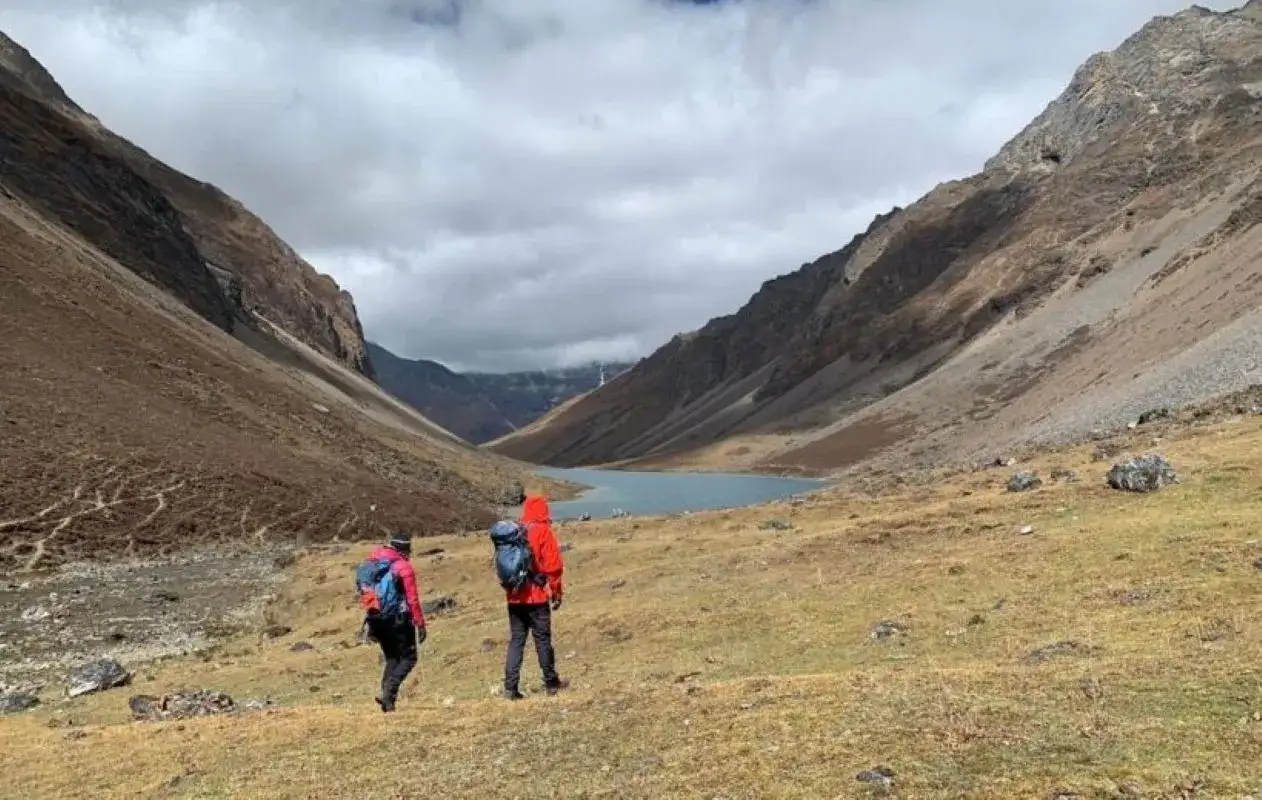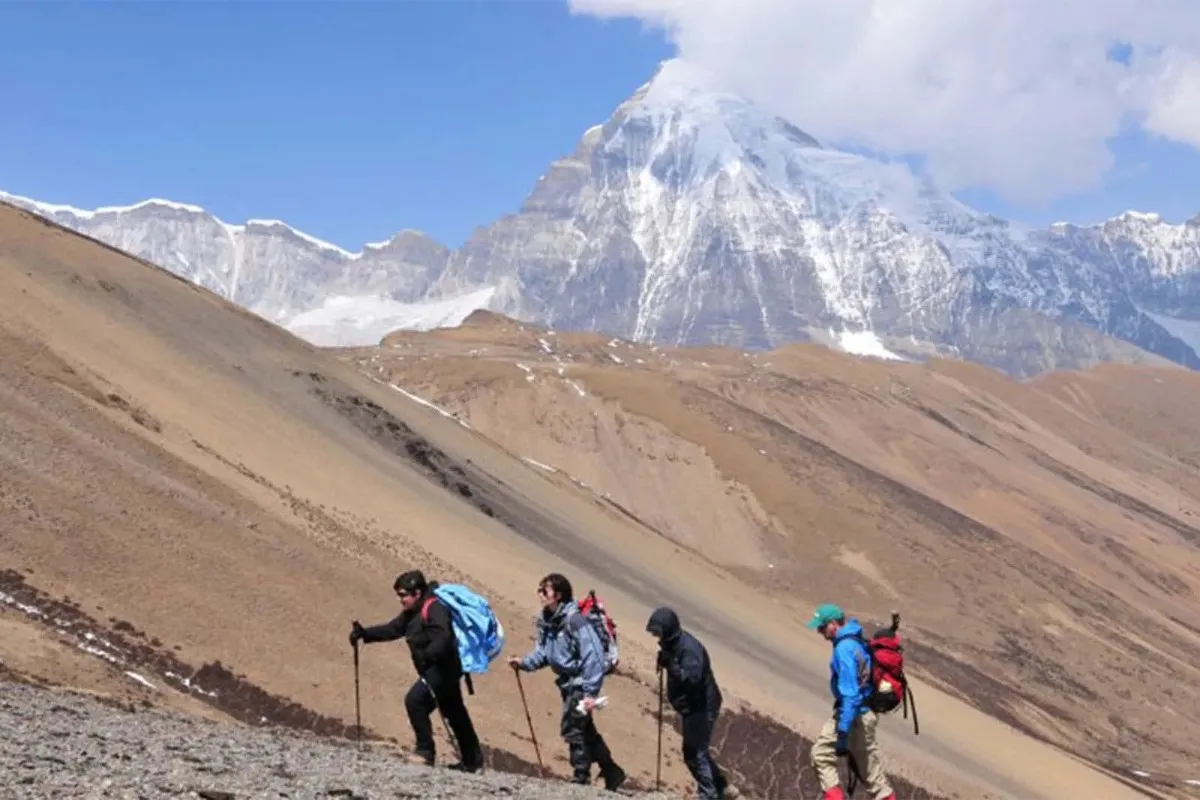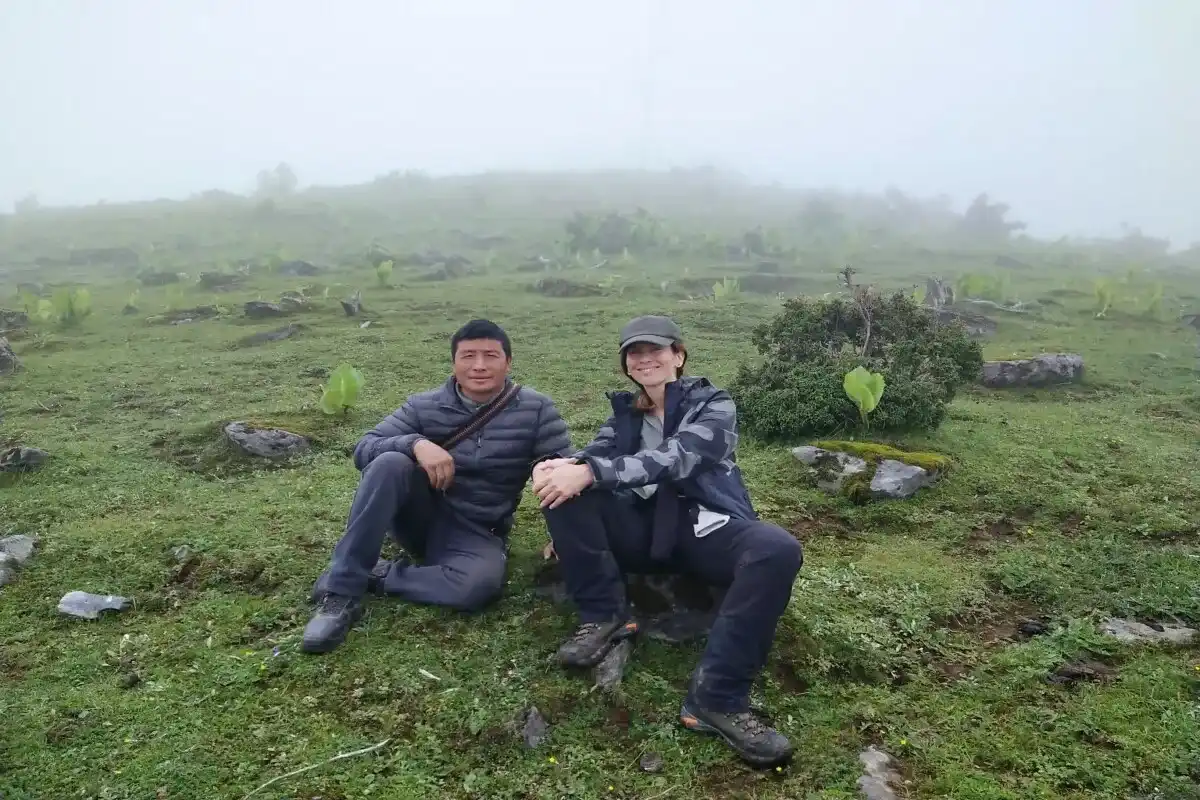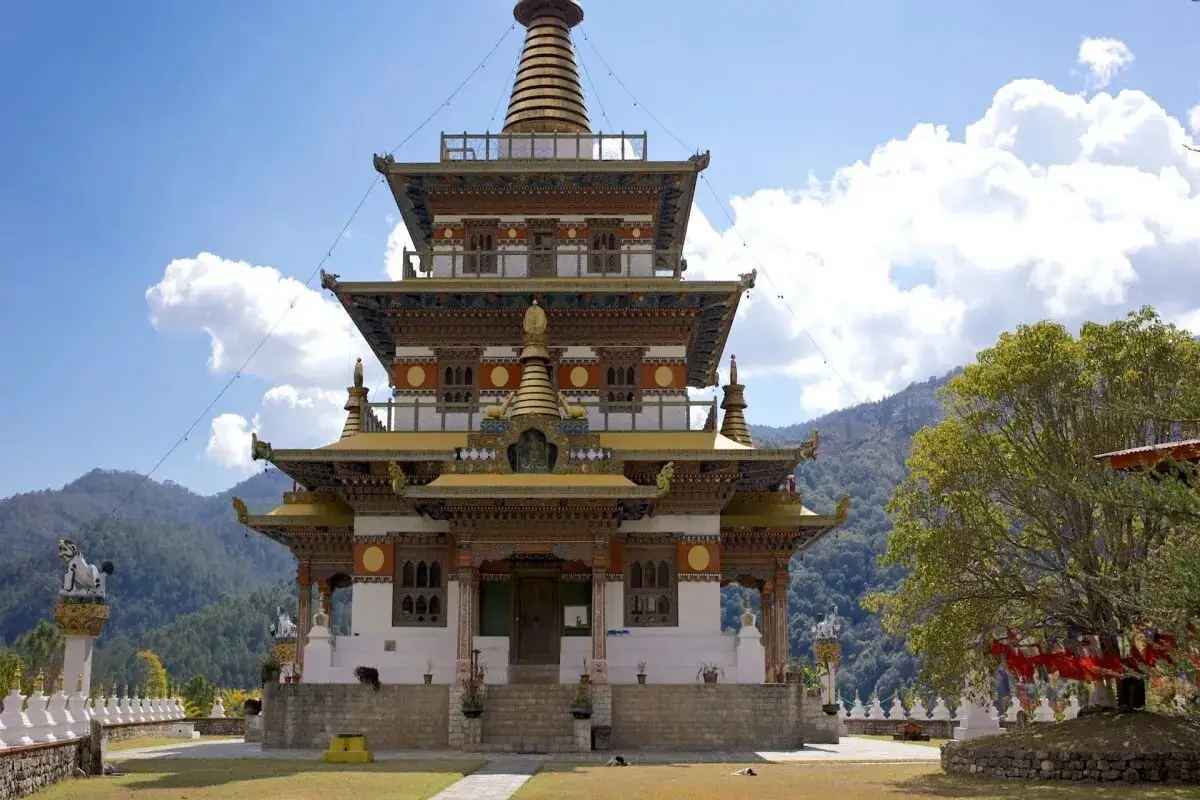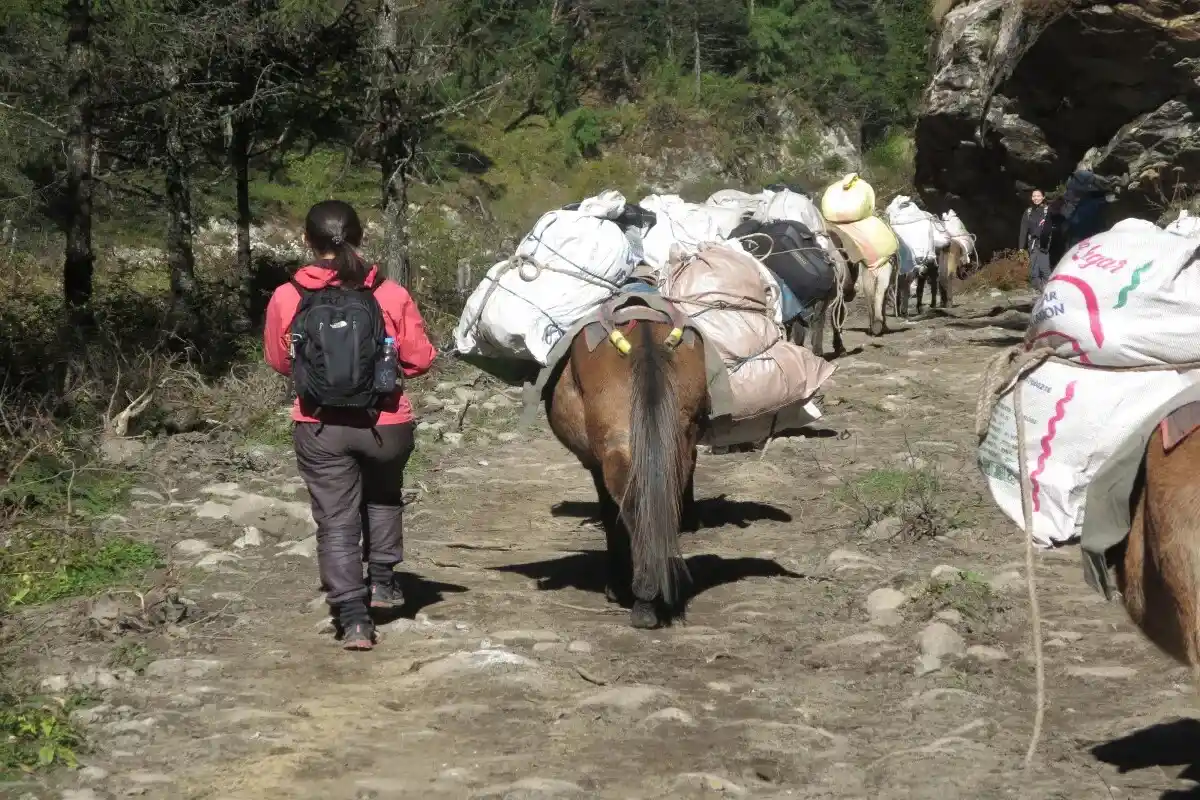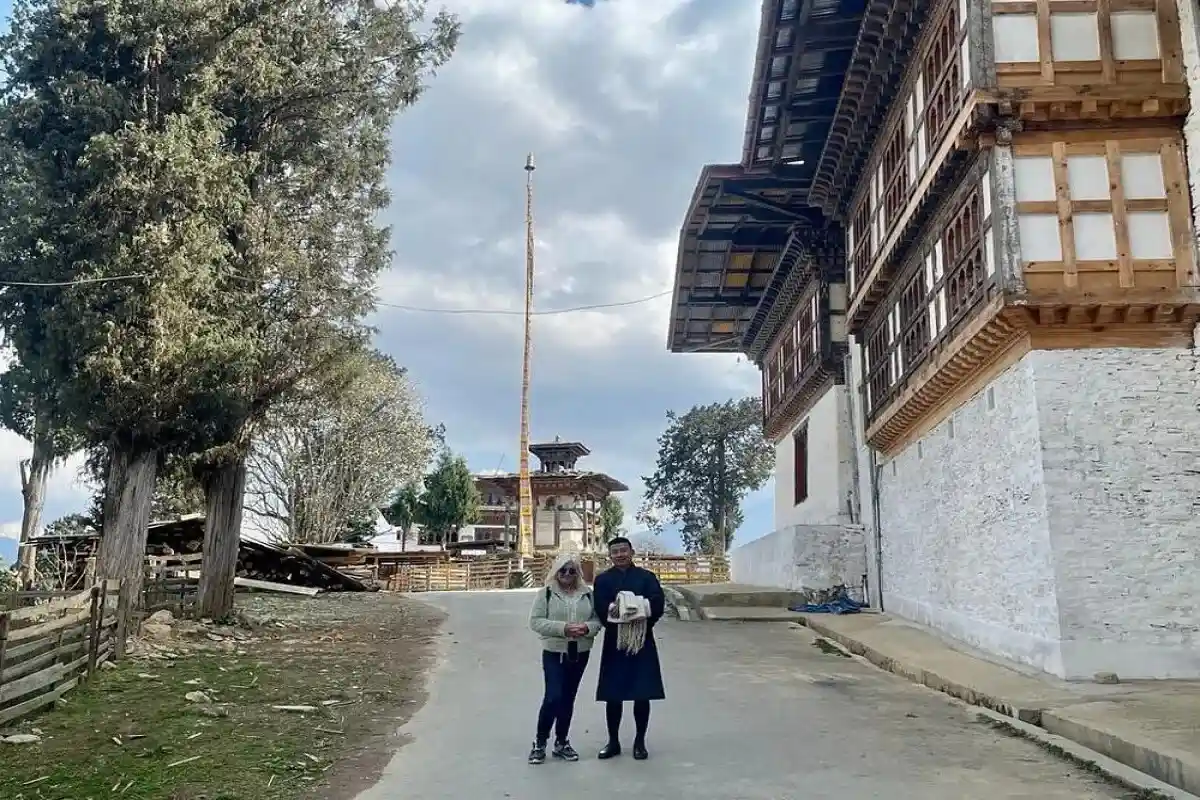Dagala Thousand Lakes Trek - 8 Days
One of the most peaceful and beautiful treks in Bhutan is the Dagala Thousand Lakes Trek. It leads you along peaceful mountain trails, ridges, and valleys that are full of wildflowers and pristine lakes. You pass through nature every day, and this nature resembles a picture: green fields, snow-covered mountains, and lakes shimmering in the sun.
Highlights of the tour
- Magical Alpine Lakes
- Breathtaking Himalayan Views
- Colorful Wildflower Valleys
- Cultural Encounters with Yak Herders
- Peace and Solitude in Nature
Trip Overview
This 8-day trip is an ideal one that suits individuals who adore nature, silence, and some adventure. You will pitch a tent directly in the open sky, have an encounter with the local yak herders, and get a view of the world-famous mountains such as Jomolhari.
This trek does not need any expert hiking skills, but a moderate fitness level is required. You will spend some hours every day walking, relaxing in quiet places, and breathing the fresh air of the mountains. Whether you're seeking a silent retreat, soul-searching solitude, or a new adventure in Bhutan, the Dagala Thousand Lakes Trek offers all this and more. It is a secret gem ready to be uncovered, a way out of the hustle and bustle of day-to-day life.
Highlights of Dagala Thousand Lakes Trek
Dagala Thousand Lakes trek is one of the most beautiful trekking destinations where you will get to explore different lakes,enjoy scenic views of Himalayas and get some refreshment.
Magical Alpine Lakes
The Dagala Trek is also one of the most beautiful lakes among several high-altitude lakes. These are clear, cool lakes that show the reflection of the sky and the mountains. Some are large and deep, while others are small and hidden. These lakes are serene and unique, and they are the best locations to spend time and enjoy nature. Some lakes are holy to the locals. These views of the lakes make the trek unforgettable.
Breathtaking Himalayan Views
You will get awesome sights of the Himalayan Mountain range at several high points along the trek. Even on clear days, you can get a view of Mount Everest, Jomolhari, Kanchenjunga, and other peaks. The best time to see the views is in the morning when the skies are clear and the light is golden. It feels like being on top of the world with the breathtaking Himalayan views.
Colorful Wildflower Valleys
Spring and summer are the times when meadows and hills on the trail are covered with wildflowers. The ground is coloured with blue poppies, rhododendrons, and a lot of alpine flowers. You may feel like walking in a garden when walking through such areas. The flowers are so beautiful that they attract birds and butterflies to make the air feel refreshed. These valleys are a delight to the heart and a beauty to the eyes, and they remind you of the simple wonders of nature at every step of the trek.
Cultural Encounters with Yak Herders
On the trail, you will also encounter yak herders in stone huts with their animals. These are families that live close to nature, and they live a traditional life. You can have an opportunity to talk, drink a cup of tea, or even just watch their calm life. It is an exclusive cultural experience that demonstrates how people can live in harmony with the land. These cordial interactions provide an understanding of the Bhutanese mountain life, which is humble, kind, and close to nature.
Peace and Solitude in Nature
The strong sense of peace is what makes this trek so special. Dagala is not crowded compared to other popular trekking trails. There is just the wind, the birds, and the crunch of your boots. It allows you to think, breathe, and just be free from stress and anxiety. Dagala is the place where you can find peace and tranquility, and get connected with yourself again, in case you are seeking to escape the hustle and bustle of life.
Why Choose the Dagala Thousand Lakes Trek?
The Dagala Thousand Lakes Trek is ideal for the person who wants a peaceful adventure in nature. It takes you away from crowded tourist destinations and into peaceful mountains with lakes, meadows, and scenic beauty. And you do not have to be an expert on climbing mountains to enjoy this trek; all you need is average fitness and a passion for the outdoors. The hike is not challenging but still thrilling with the changes of scenery each day.
The main thing about this trek is that it is peaceful. The trail is very beautiful and scenic, and you may witness rare birds and animals. You will also have an opportunity to meet local yak herders and experience their lives. With its majestic Himalayan views, nights under the open sky, and visits to sacred lakes, this trek holds deep significance. In case you are seeking a peaceful, scenic trek that appeals to your heart and soul, then this trek is for you.
Responsible Trekking Tips in Bhutan
Bhutan is a nation that upholds its environment. When hiking, one should walk gently and in a respectful manner. Bring your reusable water bottles and say no to single-use plastics. Show respect to yak herders and do not enter houses without their consent, and do not take photos without permission. Do not feed animals or pick wildflowers, because even minor alterations have an influence on the delicate high-altitude ecosystems. Never go off the trail because you will cause erosion and disruption of habitats. When you go to lakes, do not litter the water with anything, as most of them are sacred. Take back all the non-biodegradable waste and make sure that there is low noise to conserve the wildlife as well as the serene environment. As a responsible traveler, you must help Bhutan to preserve its natural heritage, which is unique, and can be passed on from one to another.
Conclusion: A Journey to Stillness and Wonder
Dagala Thousand Lakes Trek is not a simple walk in the mountains but a relaxing way of getting out of the noise of the daily routine. This trek has its silent paths, transparent lakes, and expansive mountain panoramas, which would make you relax and admire the surroundings. You will feel the real silence, enjoy the fresh air, and be close to nature step by step.
Whether you are watching the sunrise over a lake, meeting a friendly yak herder, or lying under the stars, each moment has a peaceful and magical quality to it. It is not a difficult trek, but it touches your heart. It gives you time to think about things, reflect, and get refreshed.
In case you want to experience an adventure and peace at the same time, the Dagala Thousand Lakes Trek is the one to choose. It is a lovely journey towards quiet, wonder, and you can have unforgettable memories that will last forever.
This 8-day trip is an ideal one that suits individuals who adore nature, silence, and some adventure. You will pitch a tent directly in the open sky, have an encounter with the local yak herders, and get a view of the world-famous mountains such as Jomolhari.
This trek does not need any expert hiking skills, but a moderate fitness level is required. You will spend some hours every day walking, relaxing in quiet places, and breathing the fresh air of the mountains. Whether you're seeking a silent retreat, soul-searching solitude, or a new adventure in Bhutan, the Dagala Thousand Lakes Trek offers all this and more. It is a secret gem ready to be uncovered, a way out of the hustle and bustle of day-to-day life.
Highlights of Dagala Thousand Lakes Trek
Dagala Thousand Lakes trek is one of the most beautiful trekking destinations where you will get to explore different lakes,enjoy scenic views of Himalayas and get some refreshment.
Magical Alpine Lakes
The Dagala Trek is also one of the most beautiful lakes among several high-altitude lakes. These are clear, cool lakes that show the reflection of the sky and the mountains. Some are large and deep, while others are small and hidden. These lakes are serene and unique, and they are the best locations to spend time and enjoy nature. Some lakes are holy to the locals. These views of the lakes make the trek unforgettable.
Breathtaking Himalayan Views
You will get awesome sights of the Himalayan Mountain range at several high points along the trek. Even on clear days, you can get a view of Mount Everest, Jomolhari, Kanchenjunga, and other peaks. The best time to see the views is in the morning when the skies are clear and the light is golden. It feels like being on top of the world with the breathtaking Himalayan views.
Colorful Wildflower Valleys
Spring and summer are the times when meadows and hills on the trail are covered with wildflowers. The ground is coloured with blue poppies, rhododendrons, and a lot of alpine flowers. You may feel like walking in a garden when walking through such areas. The flowers are so beautiful that they attract birds and butterflies to make the air feel refreshed. These valleys are a delight to the heart and a beauty to the eyes, and they remind you of the simple wonders of nature at every step of the trek.
Cultural Encounters with Yak Herders
On the trail, you will also encounter yak herders in stone huts with their animals. These are families that live close to nature, and they live a traditional life. You can have an opportunity to talk, drink a cup of tea, or even just watch their calm life. It is an exclusive cultural experience that demonstrates how people can live in harmony with the land. These cordial interactions provide an understanding of the Bhutanese mountain life, which is humble, kind, and close to nature.
Peace and Solitude in Nature
The strong sense of peace is what makes this trek so special. Dagala is not crowded compared to other popular trekking trails. There is just the wind, the birds, and the crunch of your boots. It allows you to think, breathe, and just be free from stress and anxiety. Dagala is the place where you can find peace and tranquility, and get connected with yourself again, in case you are seeking to escape the hustle and bustle of life.
Why Choose the Dagala Thousand Lakes Trek?
The Dagala Thousand Lakes Trek is ideal for the person who wants a peaceful adventure in nature. It takes you away from crowded tourist destinations and into peaceful mountains with lakes, meadows, and scenic beauty. And you do not have to be an expert on climbing mountains to enjoy this trek; all you need is average fitness and a passion for the outdoors. The hike is not challenging but still thrilling with the changes of scenery each day.
The main thing about this trek is that it is peaceful. The trail is very beautiful and scenic, and you may witness rare birds and animals. You will also have an opportunity to meet local yak herders and experience their lives. With its majestic Himalayan views, nights under the open sky, and visits to sacred lakes, this trek holds deep significance. In case you are seeking a peaceful, scenic trek that appeals to your heart and soul, then this trek is for you.
Responsible Trekking Tips in Bhutan
Bhutan is a nation that upholds its environment. When hiking, one should walk gently and in a respectful manner. Bring your reusable water bottles and say no to single-use plastics. Show respect to yak herders and do not enter houses without their consent, and do not take photos without permission. Do not feed animals or pick wildflowers, because even minor alterations have an influence on the delicate high-altitude ecosystems. Never go off the trail because you will cause erosion and disruption of habitats. When you go to lakes, do not litter the water with anything, as most of them are sacred. Take back all the non-biodegradable waste and make sure that there is low noise to conserve the wildlife as well as the serene environment. As a responsible traveler, you must help Bhutan to preserve its natural heritage, which is unique, and can be passed on from one to another.
Conclusion: A Journey to Stillness and Wonder
Dagala Thousand Lakes Trek is not a simple walk in the mountains but a relaxing way of getting out of the noise of the daily routine. This trek has its silent paths, transparent lakes, and expansive mountain panoramas, which would make you relax and admire the surroundings. You will feel the real silence, enjoy the fresh air, and be close to nature step by step.
Whether you are watching the sunrise over a lake, meeting a friendly yak herder, or lying under the stars, each moment has a peaceful and magical quality to it. It is not a difficult trek, but it touches your heart. It gives you time to think about things, reflect, and get refreshed.
In case you want to experience an adventure and peace at the same time, the Dagala Thousand Lakes Trek is the one to choose. It is a lovely journey towards quiet, wonder, and you can have unforgettable memories that will last forever.
Short Itinerary
Arrive in Paro – Drive to Thimphu, visit local markets, rest and briefing
Drive to Geynikha – Trek through pine forests to Gur campsite
Trek from Gur to Labatama, camp by serene Utsho Lake
Explore Relitsho, Setsho & Hentsho Lakes, acclimatize and relax
Trek to Panka via alpine meadows with mountain views
Trek to Talakha, walk scenic ridges, spot Himalayan wildlife
Descend to Chamgang – Drive to Paro, farewell dinner
Depart from Paro, fly over the Himalayas with lasting memories
Dagala Thousand Lakes Trek Itinerary
Once you arrive at Paro Airport, your guide will welcome you. Take a beautiful road trip to Thimphu, the capital of Bhutan. On the way, you will see green hills, rivers, and typical houses. After your arrival in Thimphu, check in to the hotel, and visit the local market or have a cup of hot Bhutanese tea. It is a rest day to acclimatize to the altitude and get ready for the thrilling trek that is about to come, with an evening briefing by your guide.
Drive to Geynikha, which is the point where your trek will begin. Start going through forests full of pine, bamboo, and rhododendrons. The air is fresh and clean, and you get to pass small streams and peaceful paths. After some hours of easy climbing, you will arrive at the Gur campsite, which is enclosed by green meadows and far-off hills. Get into your tent, have a warm dinner, and sleep under the sky full of stars with beautiful scenery around.
The trail today is beautiful and surprising. You will walk across flower-covered trails and over a few low hills. You will get the first glimpse of snow-capped mountains afar. The ascent is not too difficult. Reach Labatama Valley, where you will camp around Utsho Lake. This lake is wide, calm, and clear, and it is a good place to rest your tired legs. Have panoramic views of high mountains, calm water, and the open sky all around.
Today, you will explore around Labatama Lakes, as today you will acclimatize. You can spend this day visiting the nearby sacred lakes- Relitsho, Setsho, and Hentsho. These lakes are peaceful and beautiful, and you can enjoy watching trout swimming in their clear waters. You may also take a stroll up the hills near the valley to view more of the valley. It is a great day to rest, take pictures, and allow the body to adapt to the altitude. In the evening, go back to your camp, have a warm meal, and rest well.
Today, you will cross some of the highest ridges, with wonderful views of the mountains. You can see Mt. Everest and Mt. Kanchenjunga in the distance on clear days. The path climbs and descends gently, going through more alpine lakes and quiet open meadows. In the afternoon, you will come to Panka, a yak grazing ground, the quietest place possible. It is a very good place to meet herders and get to know how they live. This day, you will camp under an open sky so pitch your tent in the broad valley in Panka.
This section of the trek is one of the best in terms of the views. When you walk along the ridges, you will have the feeling that you are walking on the top of the world. The pathway goes through small streams and blooming flowers. On the way, you may see the blue sheep or the Himalayan birds. In the late afternoon, you will arrive at the Talakha Monastery area. Pitch camp nearby, with a wide view of the valleys below. You have one more night camping out in the mountains.
Descend through thick forests filled with moss-covered trees, the sound of bird calls, and the sound of silence. The path feels soft under your feet and is easy to walk. A couple of hours later, you will arrive in the village of Chamgang, and your car will be there. Head back to Paro and get into your hotel. You can either rest after a hectic journey or explore the local markets in Paro. This is the last day of your trip, so make it memorable with your trek fellows and enjoy the farewell dinner.
We will drive you to Paro Airport after having breakfast early in the morning today. Say goodbye to Bhutan, and you bring not only pictures but serene memories of lakes, mountains, and moments of quietness. Dagala Thousand Lakes Trek is an impressive one; it is not just a trek, it is a heart-touching experience. On your way out, before leaving the country, look out the airplane window and see the Himalayas one last time, and begin to dream of your next Bhutan journey.
Know Before You Travel
-
Best time to trek in Dagala Thousand Lakes:
The ideal time for the Dagala Thousand Lakes Trek is between late April and early June, and mid-September to early November. The weather during these months is clear, sunny, and suitable with blue skies and wonderful views of the mountains. During the spring (April to June), the valleys and hills are covered with wildflowers of all colors, which makes the trail appear magical. The skies tend to be the clearest in autumn (September-November) when you can get the breathtaking scenery of famous mountains such as Mt. Everest and Mt. Jomolhari.
During these months, there is also less probability of rain or snow, and that is why the trekking routes are safe and comfortable.
FAQs for Dagala Thousand Lakes Trek
It is a moderate trek. You do not have to be a pro-hiker, although you must be healthy and be able to walk 5-6 hours per day. It has a few up and down hills, but it is slow and moderate. Your guide will be with you to help all the time.
The best time to do this trek is late April to early June and mid-September to early November. These are the periods when you can view clear skies, wildflowers in bloom (spring), and spectacular Himalayan mountains.
It is a hike over 4,000 meters, and therefore, some individuals might experience minimal symptoms such as headaches or fatigue. However, the path is planned well with enough time to relax and adapt. It is good to drink lots of water and walk slowly.
You will sleep in tents at nice camping grounds. You will be served fresh food cooked by our trekking crew, who will put up the tents. The cuisine consists of a combination of Bhutanese and plain foreign foods such as rice, vegetables, soups, and eggs.
No, you must carry just a small day bag with water, snacks, and a jacket. You can hire porters if you want.
Yes, Bhutan is a very safe country; however, for solo travel, you must book a tour from a tour operator. That's why we are here to serve you. You will feel that you are well taken care of as you make the journey.
Yes, our Bhutanese travel agent will take care of all the permits and documentation before you travel.
You need a visa and all necessary permits for your trip. These documents can not be received on the day of your arrival, so they must be processed before coming here. After you book a trip with us, we will manage these papers for you. Your Bhutan visa is arranged by Orrog as part of the package.
The main way to come to Bhutan is through Paro International Airport, which is well-connected to cities like Bangkok, Delhi, Kathmandu, and Singapore. Most people arrive by air, but if you plan to come via road, you can enter through Phuentsholing, located on the southern border with India, which is the most commonly used entry point.
It is recommended to apply for the visa at least 20 days before your planned departure date so that there is enough time for processing your Bhutan visa, finalizing your itinerary, and arranging your guides and transportation. Although visa processing itself is relatively fast once payment is received, early preparation helps avoid delays and ensures availability, especially during peak seasons (spring and autumn).
You don’t require a passport-size photo for the visa, but it is wise to carry at least 2–4 recent passport-sized photographs during your trip. These may be needed for local permits, registration, or when applying for a local SIM card upon arrival in Bhutan.
Yes, you can lengthen your stay in Bhutan either before or after your trip. Bhutan’s tourism model requires visitors to pay a Sustainable Development Fee (SDF) and a daily package cost, so any extra days will involve additional charges. Extensions are a great opportunity to explore cultural sites in Paro, Thimphu, or even add another short trip or day hike.
Yes, Bhutan requires full tour payment in advance before your visa can be processed and issued. The government of Bhutan regulates this policy to ensure that all travel arrangements are confirmed through a licensed Bhutanese tour operator. We are a licensed tour operator that ensures you have everything you need for a trouble-free trip.
Any personal expenses are not covered in the package like:
- Tips for your guide and other staff
- Bottled drinks and snacks(personal expense)
- Souvenirs or local crafts
Credit cards are easily accepted in major cities like Paro and Thimphu. But in remote areas, you may not have access to a card or an ATM. So, it is best to carry some cash before heading for the trip.
Tipping is not mandatory, but it is a widely appreciated gesture and a customary way to show gratitude for good service. The tipping guideline would be to give USD 5-10 per day as a tip for the guides and other staff.
Paro International Airport is the only international airport in Bhutan. It is well connected by flights from cities like Bangkok, Delhi, Kathmandu, and Singapore.
Yes, airport pick-up and drop-off are included in the package. We will have your guide and driver meet you at the airport and transport you to your hotel.
While Bhutan's roads are mostly paved, some parts are narrow, winding, and occasionally affected by weather. However, we ensure your travel is safe, well-maintained, and driven by an experienced professional throughout the journey.
The Bhutanese Ngultrum is used in Bhutan. All local transactions during the trip will be in BTN.
US Dollars (USD) are generally accepted at larger hotels, souvenir shops, and tour operators, particularly in Paro and Thimphu. However, it’s advisable to convert your currency to BTN for general purchases in rural areas. Other currencies like the Euro or the Pound are not commonly accepted directly.
No, credit or debit cards are not accepted on the trip, as it takes you through remote regions with no banking or electronic payment access. All trip-related payments like accommodation, meals, permits, etc, are paid in advance.
You can exchange foreign currency at the Paro International Airport, at banks, or through licensed money changers in cities like Thimphu and Paro. It's best to exchange enough cash before heading out on the trip.
The national language is Dzongkha, but many Bhutanese also speak English. If you speak English and are worried about communicating with the local people, you will have your guide as a translator.
Yes, all licensed tour guides in Bhutan are required to speak fluent English. Many are also trained in other languages such as German, Japanese, or French. Communication during the trip will be smooth and clear in English.
Most signboards, tourist maps, and information brochures are written in English, especially in tourist destinations like Paro, Thimphu, and trailheads. Directional signs along routes are often labeled in both Dzongkha and English.
No, learning Dzongkha is not at all needed for the trip, but knowing a few basic words like "Kuzu zangpo la" (Hello) or "Kadrinche la" (Thank you) is a good way to interact with the locals.
Language barriers are minimal, as your guide will handle all communication with locals and support staff. Your guide will translate for you during your interaction with the locals.
To greet people, you can greet with locals “Kuzu zangpo la” (Hello) by performing a slight bow. Most common greetings include physical greetings, such as shaking hands less visible, especially in rural areas.
Yes, but remember to seek permission, especially when taking photos of monks, locals, or temples. Please note that clicking photos is not allowed at most religious sites.
Visitors should dress modestly and respectfully. This means:
- Covering shoulders and knees
- Removing hats and sunglasses
- Not wearing shorts or sleeveless tops
This applies to both men and women.
Yes, Bhutanese society is deeply rooted in Buddhism and tradition. Here are some key taboos:
- Do not point your feet at people or sacred objects
- Never touch anyone on the head, as it is considered sacred
- Walk clockwise around temples, stupas, and religious monuments
- Avoid public displays of affection
While gifts are not expected, they may be accepted graciously if given with respect. It is advisable to consult with the guide before giving out anything.
Bhutan typically uses Type C, Type D, and Type G electrical outlets. Standard safe voltage is 230V and frequency is 50Hz; therefore, ensure that your equipment is compatible with this voltage.
Indeed, it is highly advised to take along a universal travel adapter, particularly one to fit a variety of types of plugs, because plugs can be different in a hotel or a guesthouse.
Bhutan follows Bhutan Time (BTT), which is UTC/GMT +6 hours. This time zone remains consistent throughout the year.
No, Bhutan does not observe daylight saving time. The country maintains the same time year-round.
Bhutan is 30 minutes ahead of India. For example, 12:00 PM in India is 12:30 PM in Bhutan.
Yes, souvenirs can be bought in Paro or Thimphu before or after the trip.
Some popular souvenirs include hand-woven textiles (kira and gho fabric), prayer flags, thangka (religious scroll) paintings, handmade paper products, traditional masks, and Buddhist artifacts.
You can do some gentle bargaining in local street markets. However, in government-run shops and fixed-price stores, prices are usually non-negotiable.
Yes, you can easily purchase a SIM card upon arrival in Bhutan. We will assist you with the process, and you'll need a passport copy and a passport-sized photo.
No, internet access is not available during the trip. However, Wi-Fi is available in hotels in Paro and Thimphu before and after the trip.
Yes, it is highly recommended to inform friends and family before the trip that you will be offline for several days, so they are not concerned by the lack of communication.
B-Mobile (by Bhutan Telecom) and TashiCell are the two main service providers. B-Mobile tends to have better coverage in rural and mountainous areas.
Yes, snow is quite likely, especially at higher elevations, which are above 4,800 meters. If you trek during late autumn (October–November) or early spring (March–April), you may encounter snowfall. During the peak of spring (April–May) and autumn (September–early October), trails are usually clear, although sudden weather changes in the mountains can still bring unexpected snow showers. You should always be prepared for cold conditions and potential snowfall, regardless of the season.
No, Treks are not accessible throughout the year. The trail is generally closed during the winter(December- February) due to heavy snowfall that makes high mountain passes impassable and increases the risk of avalanches and extreme cold.
Since the weather can be unpredictable and temperatures can vary drastically, layered clothing is essential. You should pack:
- Base layers (thermal tops and bottoms)
- Insulating layers like fleece or down jackets
- Waterproof and windproof outer layers
- Warm hats, gloves, and neck gaiters for freezing conditions
- Moisture-wicking socks and weatherproof trekking boots
The weather is clear with mild daytime temperatures during spring and autumn. But you will be travelling in high altitudes, so it is necessary to carry enough clothing because you will encounter lower temperatures. The nights are freezing cold at high altitudes. So, pack accordingly.
The Jomolhari Trek is classified as moderate to strenuous, basically due to its location, the long trail, and several days of camping. The track, although not tough, is more suited to people who have earlier hiking or trekking experience. Beginners with good fitness and determination can still complete the trek, but we recommend undertaking some pre-trip training, such as having a long walk or doing some cardio exercises.
This trip is mainly for people aged between 12 and 65. But if you are physically fit and have the willpower to complete this trek, you can complete this trek because we will be there to help you in case of any problem.
A Medical certificate is not mandatory, but a health check-up is advised. Since the trek reaches altitudes over 4,800 meters (15,750 feet), you can have a normal checkup before the trek to make sure that you have no ongoing issues.
Yes, your children can join the trek if they are in good physical condition, which requires walking for a few hours every day. They should have parental guidance during the trek.
Yes, senior citizens can participate, given that they are fit to complete this trek. A visit to the Doctor is strongly advised, and seniors should engage in pre-trek training to improve stamina and cardiovascular health.
During this Trek, you will stay in tented camps at remote, scenic campsites along the trail. These camps are fully supported and managed by us. Before and after the trek, you will stay in comfortable hotels or guesthouses in Paro and Thimphu. All accommodations are arranged by us as part of your package.
Yes, all campsites are carefully chosen, keeping safety, cleanliness, and hygiene in mind. Orrog follows strict sanitation practices, including setting up toilet tents, safe waste disposal, and clean food preparation areas. You’ll also be accompanied by well-trained staff to ensure your safety during the trip.
Yes, we provide a high-quality sleeping bag in the package, which is suitable for sub-zero temperatures of the high-altitude regions. However, you can bring your sleeping bag if you prefer additional comfort or hygiene.
Yes, hot water for drinking is available at camps, but not hot water for showers. You can carry biodegradable wet wipes for convenience.
Each campsite is equipped with portable toilet tents or simple pit latrines, maintained by the support team to ensure cleanliness and privacy. While they are basic, they are safe, hygienic, and environmentally conscious. It is advisable to carry your toilet paper, hand sanitizer, and eco-friendly toiletries to maintain hygiene during the trek.
If you experience symptoms such as headache, nausea, dizziness, or fatigue, your guide will have you rest, hydrate, and monitor your condition closely. If symptoms worsen, you will be taken to a lower altitude immediately, which is the most effective treatment. All treks are designed with gradual altitude gain and acclimatization days to minimize the risk.
Yes, emergency helicopter evacuation is available in Bhutan and can be arranged in serious cases such as severe altitude sickness or injury. However, helicopter rescue is costly and not included in standard trek packages, so having travel insurance that covers emergency evacuation is mandatory. Guides and tour operators are trained to handle emergencies efficiently and will contact authorities for evacuation if needed.
This trek is moderate to tough with 6–8 hours of walking per day across rugged terrain and steep trails. The altitude, length, and remote conditions require good physical fitness and preparation.
Yes, emergency helicopter evacuation is available in Bhutan and can be arranged in serious cases such as severe altitude sickness or injury. However, helicopter rescue is costly and not included in standard trek packages, so having travel insurance that covers emergency evacuation is mandatory. Guides and tour operators are trained to handle emergencies efficiently and will contact authorities for evacuation if needed.
Yes, travel insurance is mandatory for all international travelers visiting Bhutan, especially for those trekking at high altitudes. Your insurance must cover:
- Emergency medical treatment
- High-altitude trekking (above 4,000 meters)
- Helicopter evacuation and return to the home country
- Trip cancellation or delay
Proof of insurance may be requested before your visa is processed. Make sure to read your policy details carefully or consult with your insurance provider before travel.
Yes, travel insurance is mandatory for this trek. Your policy must include coverage for high-altitude trekking (above 4,000 meters), medical emergencies, and helicopter evacuation, as these services can be very costly in remote Bhutanese terrain. Proof of insurance may be required by your tour operator before confirming the trek.
Mobile network coverage is extremely limited along the Trek. While you may get occasional signal in some lower-altitude areas or villages, most of the trail is out of range, especially near the high passes and campsites. It’s best to inform family and friends that you may be offline for several days.
Charging facilities are not available on the trail since the trek passes through remote and non-electrified areas. It is strongly recommended to bring a high-capacity power bank or a solar charger to power essential devices like phones or cameras during the journey.
Yes, you should bring personal gear such as trekking boots, warm and waterproof clothing, gloves, hats, and a sleeping bag. The other necessary items will be managed by us.
Meals are prepared fresh daily by the trek support team and typically include Bhutanese and Tibetan-style dishes like rice, curries, noodles, soups, vegetables, and occasional meat. Tea, coffee, and snacks are also provided. If you have diet restrictions (vegetarian, vegan, gluten-free, etc.), inform your tour operator in advance so arrangements can be made.
Trekking in Bhutan follows strict environmental protocols, including the “Leave No Trace” principle. All trash is collected and carried out by the support team. Trekkers are expected to avoid littering and carry personal non-biodegradable waste, such as snack wrappers or batteries, back to base.
Yes, safe drinking water is provided each day. You are also encouraged to bring a refillable water bottle and, optionally, water purification tablets or a filtration bottle for additional safety and convenience.
You can prevent Altitude sickness by following these tips:
- Ascend gradually and allow time for acclimatization
- Drink plenty of fluids, preferably water and warm drinks
- Avoid alcohol and caffeine
- Eat light but frequent meals
- Communicate with your guide immediately if you feel unwell
Common symptoms include:
- Headache
- Nausea or vomiting
- Dizziness or light-headedness
- Shortness of breath
- Loss of appetite
- Fatigue or difficulty sleeping
Occasionally, you might meet villagers selling handmade items like yak wool scarves or woven baskets near campsites or small settlements. These are authentic and support local communities.
Only some larger shops in cities like Paro and Thimphu accept credit cards. The remote areas might not have a card payment option, so we suggest that you carry some cash.
Yes, souvenirs can be bought in Paro or Thimphu before or after the trip.
Some popular souvenirs include hand-woven textiles (kira and gho fabric), prayer flags, thangka (religious scroll) paintings, handmade paper products, traditional masks, and Buddhist artifacts.
You can do some gentle bargaining in local street markets. However, in government-run shops and fixed-price stores, prices are usually non-negotiable.
Reviews & Ratings
-
Guarantee -
Thimphu,Bhutan -
975+17160228
Ready to Explore Bhutan?
Start your journey today and discover the magic of Bhutan with our expert guides and carefully crafted tours.
Book This Trip
-
No booking or credit card fees -
Best price guarantee -
Full customize trip
Ask a Question
Feel free to ask us anything about this tour. A travel expert will then get back to you as soon as possible
Ready to Explore Bhutan?
Start your journey today and discover the magic of Bhutan with our expert guides and carefully crafted tours.

